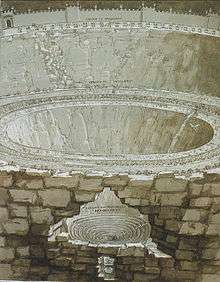Dis (Divine Comedy)
In Dante Alighieri's The Divine Comedy, the City of Dis (Italian: Dite Italian pronunciation: [ˈdiːte]) encompasses the sixth through the ninth circles of Hell.[1] Before the City is reached, in ninth canto, Dante encounters the unbaptised and then those who sinned by self-indulgence—the lustful, the gluttons, the misers and spendthrifts—and at the outskirts of the red-hot walls of City of Dis are the wrathful and those of ill-will. From this point on we find sinners who acted out of malice and wickedness. Immediately within the walls of the City are the Heretics, who disbelieved in immortality are forever imprisoned in red-hot tombs. Beyond are rings of those who were violent—to others, to themselves (suicides), to God (blasphemers), to art (usurers), and to nature (sexual perverts). Beyond the ruins of Dis are the frauds and corruptors, and finally the traitors.

In ancient Roman mythology, Dis Pater ("Father Dis") is the ruler of the underworld and is named as such in the sixth book of Virgil's "Aeneid", one of the principal influences on Dante in his depiction of Hell (the god was also known as Pluto, a name not used by Virgil in the Aeneid). The hero Aeneas enters the "desolate halls and vacant realm of Dis"[2] with his guide, the Sibyl, who correspond in The Divine Comedy to "Dante" as the speaker of the poem and his guide, Virgil.
Description
The walls of Dis are guarded by fallen angels, the Furies, and Medusa. Dante emphasizes the character of the place as a city by describing its architectural features: towers, gates, walls, ramparts, bridges, and moats. It is thus an antithesis to the heavenly city, as for instance described by St. Augustine in his book City of God.[3] Among these structures are mosques,[4] "the worship places of the most dangerous enemies of medieval Christendom."[5] In Dante's schematics of Hell, some Muslims and Jews are placed among the heretics. The presence of mosques probably also recalls the reality of Jerusalem in Dante's own time, where gilded domes dominated the skyline.[6]
Punished within Dis are those whose lives were marked by active (rather than passive) sins: heretics, murderers, suicides, blasphemers, usurers, sodomites, panderers, seducers, flatterers, Simoniacs, false prophets, barrators, hypocrites, thieves, fraudulent advisors, sowers of discord, falsifiers, and traitors. Sinners unable to control their passions offend God less than these, whose lives were driven by malizia ("malice, wicked intent"):
Of every malice (malizia) gaining the hatred of Heaven, injustice is the goal; and every such goal injures someone either with force or fraud.[7]
There is perhaps a distinction between malizia as the characteristic of circles seven and eight, and the matta bestialitade, "inhuman wickedness," of circle nine, which punishes those who threaten "the most basic civic, familial, and religious foundations of happiness."[8]
See also
References
- Inferno 9.106 to 34.81. Citations from The Divine Comedy, unless otherwise noted, are those of H. Wayne Storey, entry on "Dis," in The Dante Encyclopedia (Routledge, 2010), pp. 306–307.
- Domos Ditis uacuas et inania regna (Aeneid 6.269).
- Storey, The Dante Encyclopedia, p. 306.
- Dante, Inferno, 8.70 "meschite"; Ciardi's annotation to this verse: "To a European of Dante's time a mosque would seem the perversion of a church, the impious counterpart of the House of God, just as Satan is God's impious counterpart. His city is therefore architecturally appropriate, a symbolism that becomes all the more terrible when the mosques are made of red-hot iron." John Ciardi, trans., The Inferno (1954, NY, Mentor Classic) page 85.
- Peter Bondanella, The Inferno: Dante Alighieri, note to the translation of Henry Wadsworth Longfellow (Fine Creative Media, 2003), pp. 206–207.
- Anthony K. Cassell, "The Tomb, the Tower and the Pit: Dante's Satan," in Dante: Dante and Interpretation (Routledge, 2003), p. 204.
- 11.22–24, as cited by Storey, The Dante Encyclopedia, p. 307.
- Storey, The Dante Encyclopedia, p. 307.